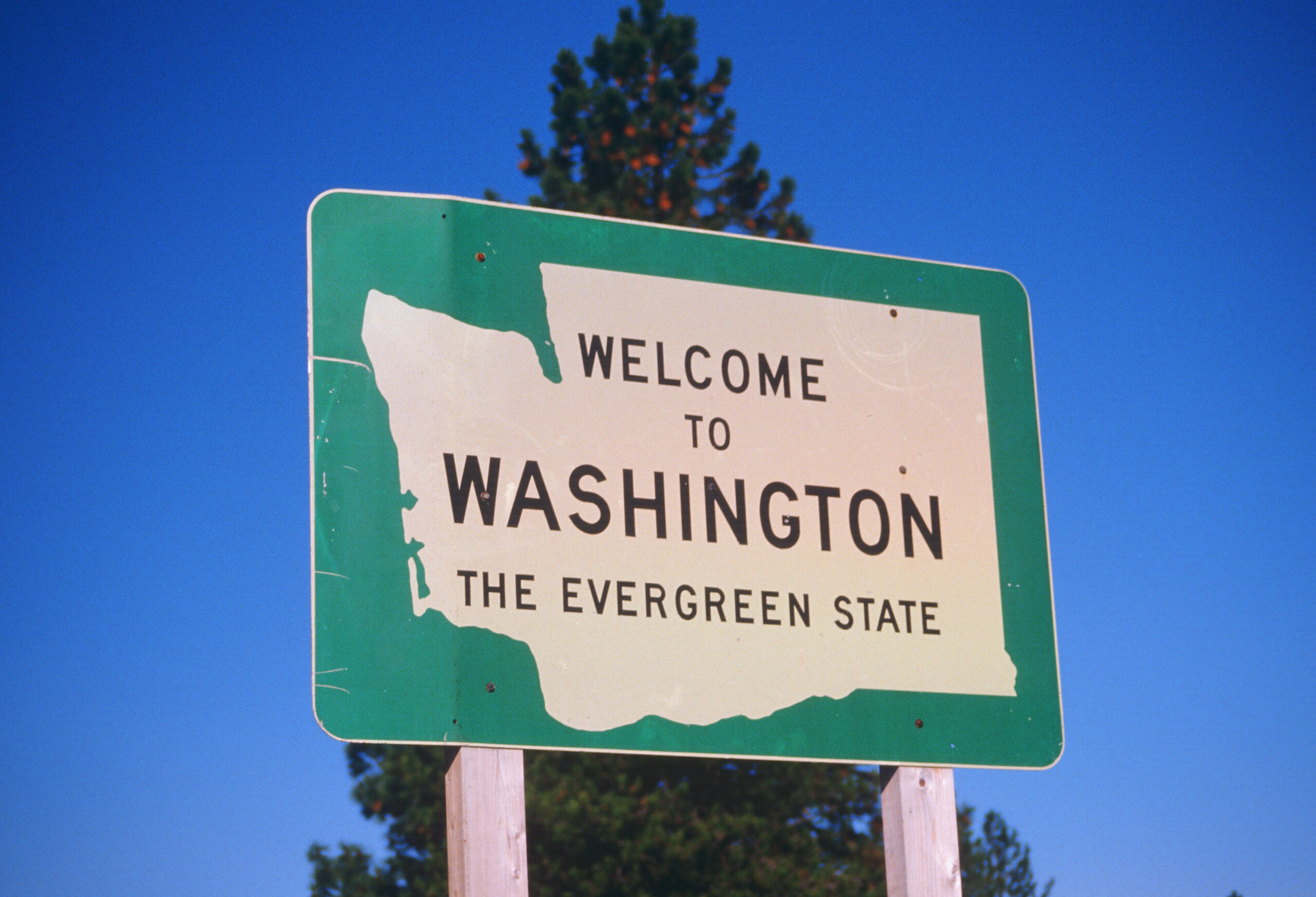There are places where geography feels almost human — where land, water, and weather hold moods, tempers, and silences that seem to speak. Washington State is one of those places. Tucked in the far northwestern corner of the continental United States, it stretches from the wild Pacific coast to the towering Cascade Mountains, from glacial peaks to vineyards ripening in dry, golden hills.
This is a state defined by contrast and convergence — where mist-shrouded rainforests meet volcanic summits, and modern cities rise from the shadow of ancient cedars. Washington is at once ancient and futuristic, a place where Native legends, timber towns, and tech capitals coexist in uneasy harmony. It is the homeland of the Coast Salish people, the muse of poets and climbers, and the birthplace of grunge and espresso culture.
To journey through Washington is to follow the path of water: from snowmelt on Mount Rainier to the deep currents of Puget Sound, from the Columbia River’s restless power to the quiet lakes that gather light like secrets. Every turn of the landscape seems to hold its own rhythm — a music of rain on leaves, gulls over tide flats, wind in wheat fields.
Here, nature isn’t just scenery — it’s presence. It demands attention, humility, and awe. The forests of the Olympic Peninsula breathe with prehistoric life; the North Cascades slice the horizon like frozen waves. And beyond the coast, the San Juan Islands drift like forgotten dreams on the water.
To know Washington is to understand that beauty here is rarely gentle. It’s elemental — raw, changing, and immense. It humbles the traveler, yet invites them to linger, listen, and become part of the living story the land continues to write.
Seattle: The City of Sky and Sound
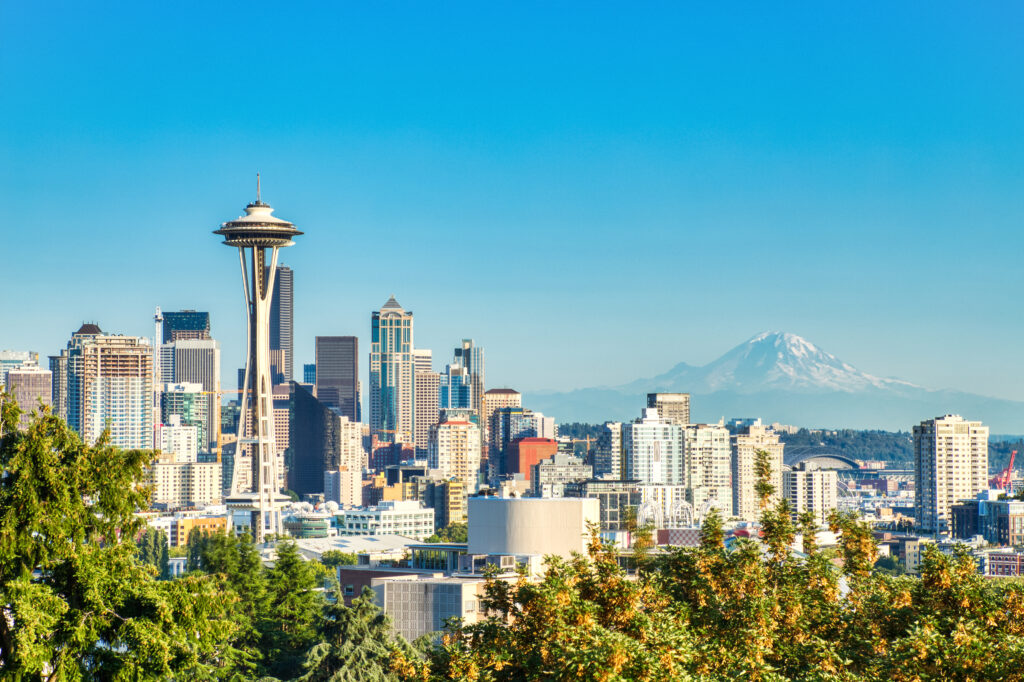
Seattle rises between mountains and sea, a city balanced on the edge of wilderness. With the snow-capped Olympics to the west and Mount Rainier looming like a ghost in the east, it feels suspended between two immensities. The light here is mercurial — silver in the morning, blue in the afternoon, molten gold at sunset when the ferries cut their quiet paths across Puget Sound.
The city’s rhythm is shaped by water: rain on rooftops, fog lifting from Elliott Bay, and the call of gulls over the piers. It’s also shaped by ambition — the birthplace of innovation from Boeing to Microsoft to Amazon, where creativity thrives under gray skies. But for all its modern pulse, Seattle remains deeply rooted in place. Pike Place Market hums with local color; neighborhoods like Ballard and Fremont keep a sense of individuality that defies uniformity.

Art and nature blur together here. Glass sculptures bloom in Chihuly Garden; towering evergreens ring Discovery Park; and the Space Needle — that futuristic relic of the 1962 World’s Fair — still captures the city’s enduring optimism.
Seattle’s essence is not in its skyline, but in its atmosphere: the scent of salt and coffee, the slow drift of drizzle over Lake Union, the quiet pride of a city that has always looked outward — to the Pacific, to Asia, to possibility.
Olympic National Park: The Kingdom of Rain and Silence
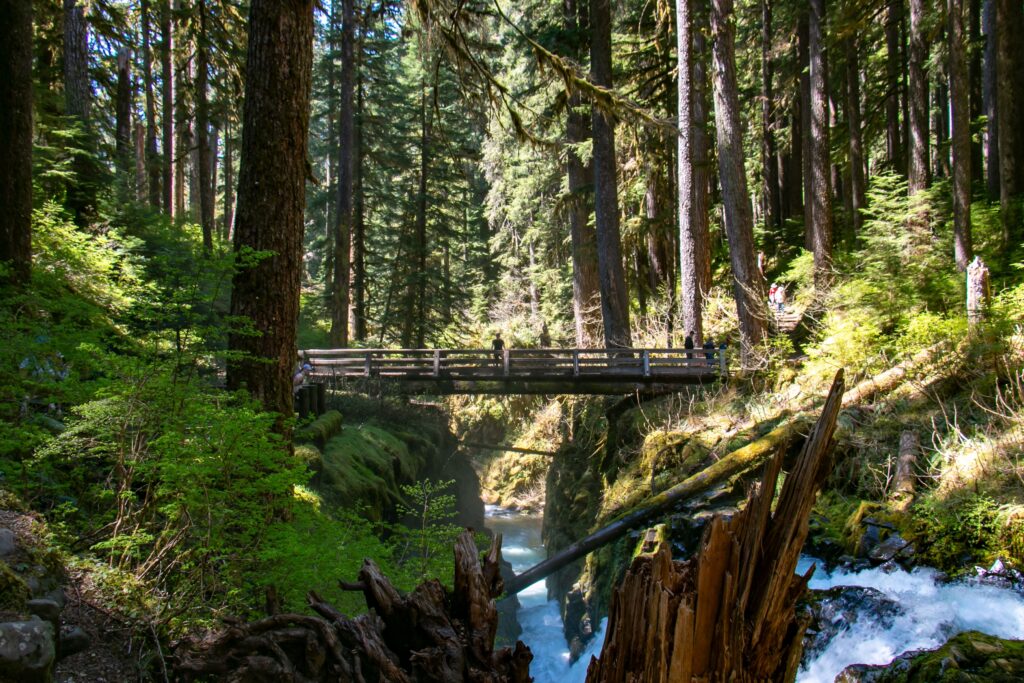
Few places on Earth contain so many worlds within a single boundary as Olympic National Park. Stretching from the Pacific coast to glacial peaks, it is a sanctuary of extremes: tide pools glistening with sea stars, moss-draped forests where silence hums, and mountains crowned with ice and cloud.

The Hoh Rain Forest, a cathedral of green, feels timeless. Douglas firs and Sitka spruces rise hundreds of feet, their trunks veiled in moss and ferns. Rain here is not weather — it’s identity. Each drop sustains a universe of life so intricate it seems infinite.

Farther west, the ocean asserts its power. At Rialto Beach and Ruby Beach, the sea meets land in a thunder of surf, the sand scattered with driftwood as massive as ships. Sea stacks rise like ancient sentinels from the mist — reminders that this coast is always in motion, always remaking itself.
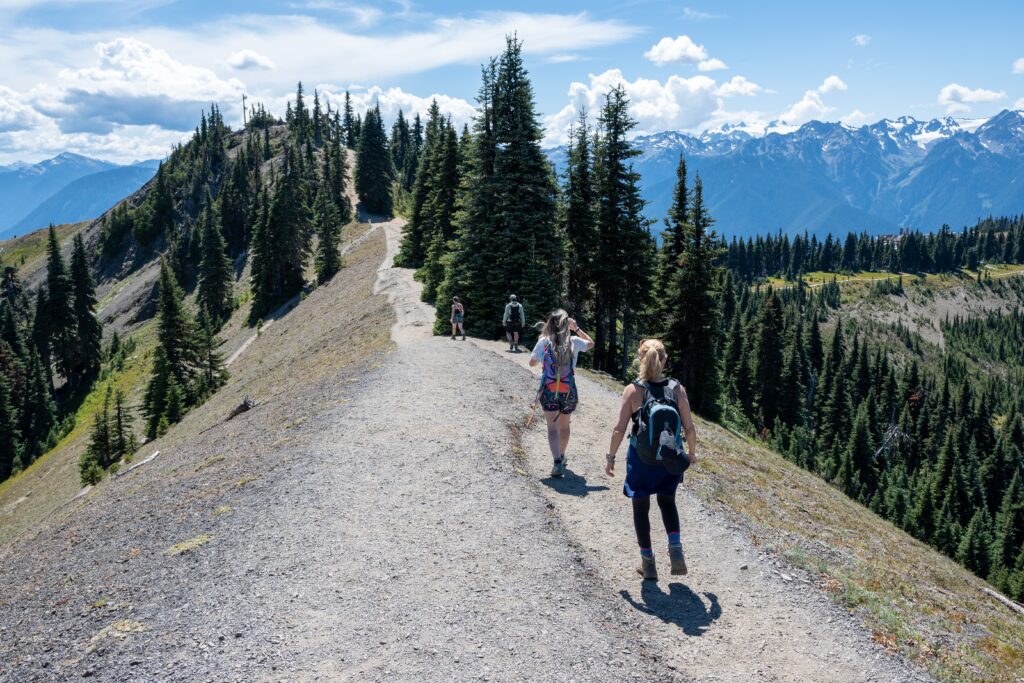
And then, at the park’s heart, stand the Olympic Mountains — jagged, glaciated, unreachable. From Hurricane Ridge, the view stretches to infinity: snowfields, valleys, and the shimmer of the Strait of Juan de Fuca.
Olympic is not a park to visit; it’s a world to enter. It invites reverence, not conquest — a living testament to how wildness still breathes in the modern world.
Mount Rainier National Park: The Great White Monarch

Everywhere in western Washington, Mount Rainier reigns — a colossal presence that defines the horizon, weather, and imagination. Known to the Indigenous Puyallup people as Tahoma, “the mountain that was god,” it rises more than 14,000 feet, sheathed in glaciers and myth.
To stand before Rainier is to feel perspective restored. The mountain commands silence. Its scale is impossible to measure — not only in size, but in the way it captures light: pink at dawn, violet at dusk, wrapped in a crown of storms.

Trails wind through meadows of wildflowers at Paradise and Sunrise, where marmots whistle among lupines and waterfalls pour from ice. Climbers test themselves on its perilous slopes, while others simply gaze in awe, understanding that some summits are best admired, not conquered.
Rainier is both beauty and warning — a volcano sleeping beneath its glaciers, a reminder that all creation is temporary. Yet its presence comforts, too: constant, patient, eternal. In its shadow, the forests grow, the rivers flow, and life continues in quiet reverence.
North Cascades National Park: The American Alps

They call it the American Alps, and the name does not exaggerate. The North Cascades are fierce, remote, and heartbreakingly beautiful — a wilderness of crags and glaciers that feels almost mythic in its solitude. More than 300 glaciers carve the granite spires; deep valleys plunge into forests of cedar and hemlock where wolves, black bears, and mountain goats still roam.
This is a land for those who crave humility before nature. Roads touch only its edges; beyond them lies silence — not emptiness, but presence. Trails like Cascade Pass or Maple Loop reveal a world of alpine meadows aflame with wildflowers, lakes the color of jade, and ridgelines that fade into eternity.

At dawn, the peaks burn rose-gold, their reflections trembling on still waters like a painter’s dream. By night, the stars seem close enough to touch. Here, modern time dissolves — replaced by the slow rhythm of snowmelt and stone.
The North Cascades are not merely scenery; they are a reminder of the scale of the Earth, and of how little we need to feel whole.
The San Juan Islands: An Archipelago of Quiet Dreams
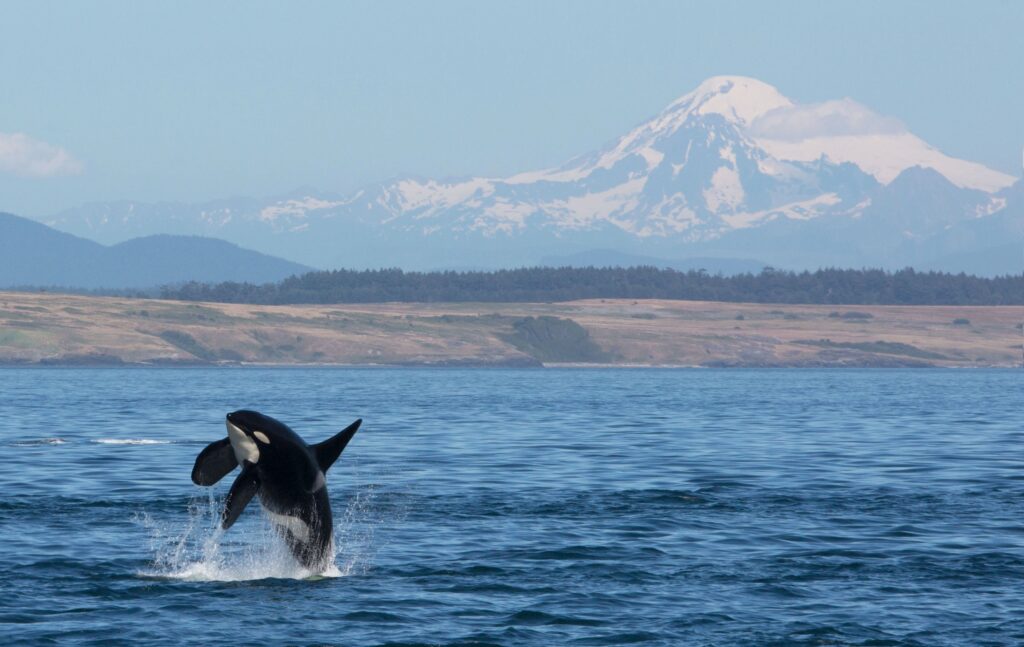
Scattered like stepping-stones across the inland sea between Washington and Canada, the San Juan Islands are a world apart — a constellation of over 170 islands where time drifts as slowly as the tides.

Ferries thread through mist and sun, their wakes gleaming behind them like ribbons. On San Juan Island, lavender fields scent the breeze; Orcas Island rises in green folds toward Mount Constitution, with views that stretch from Vancouver Island to Mount Baker. Deer move through orchards, eagles wheel above kelp beds, and in the glittering channels, orcas hunt and play — dark fins cutting through the silver water.
Each island has its own rhythm: Lopez is friendly and rural, Shaw monastic and private, Orcas artistic and wild. There are galleries in old barns, wooden boats in harbors, and cafés that seem suspended in endless summer.
To visit the San Juans is to step into stillness — a kind of geography of peace. It’s the gentle counterpoint to Washington’s mountains: an archipelago that whispers rather than roars.
Puget Sound: The Tides of Civilization and Calm

Puget Sound is the heartbeat of western Washington — a labyrinth of deep inlets, islands, and peninsulas where salt water and civilization intertwine. Here, ferries glide like floating cities, carrying commuters and dreamers alike between Seattle, Bainbridge, Whidbey, and beyond.
The Sound is not a single body of water but a living system: a mingling of rivers, tides, and estuaries that sustains salmon, seals, herons, and the elusive orca. Its moods shift constantly — glassy and blue at morning, steel-gray under clouds, golden at dusk when the Olympics catch fire across the horizon.

Along its shores, old maritime towns like Gig Harbor and Port Townsend preserve echoes of wooden-boat culture; shipyards clatter beside marinas; lighthouses blink across fog. Even amid the bustle of modern Seattle, the salt tang in the air reminds one that this is a maritime civilization — born of water, commerce, and daring.
Puget Sound embodies Washington’s paradox: at once urban and wild, industrious yet reflective. To stand on its shore is to feel the world’s edges blur — sea becoming sky, motion becoming stillness.
Tacoma: The Grit and Grace of a Reborn City
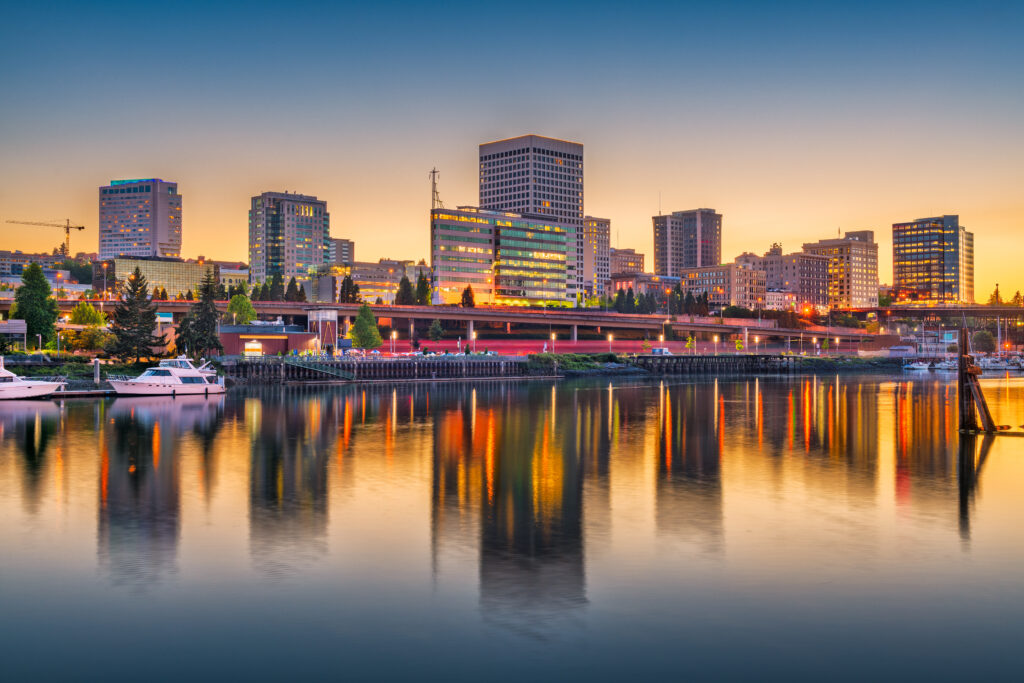
For much of its history, Tacoma was known as Seattle’s shadow — a working port, a city of mills and rails. But in recent decades, it has quietly transformed into one of the Pacific Northwest’s most soulful places, where creativity grows from the bones of industry.
The Museum of Glass, with its flaming hot shop and sweeping architecture, stands as a symbol of that renewal. Its Chihuly Bridge of Glass — shimmering with color and light — links the downtown waterfront to the Tacoma Art Museum, both testaments to the city’s artistic rebirth. Old warehouses have become galleries and coffee roasteries; the aroma of roasted beans mingles with salt air along the restored Thea Foss Waterway.

Yet Tacoma has not lost its edge. Cargo ships still moor beneath cranes, trains still echo through the night. That mix — art and industry, beauty and backbone — gives Tacoma its character.
Mount Rainier dominates the skyline, close enough to feel like a guardian. And in its shadow, Tacoma continues to evolve, grounded in authenticity, proud of its past, and certain of its future.
Bellingham: Where the Mountains Meet the Sea
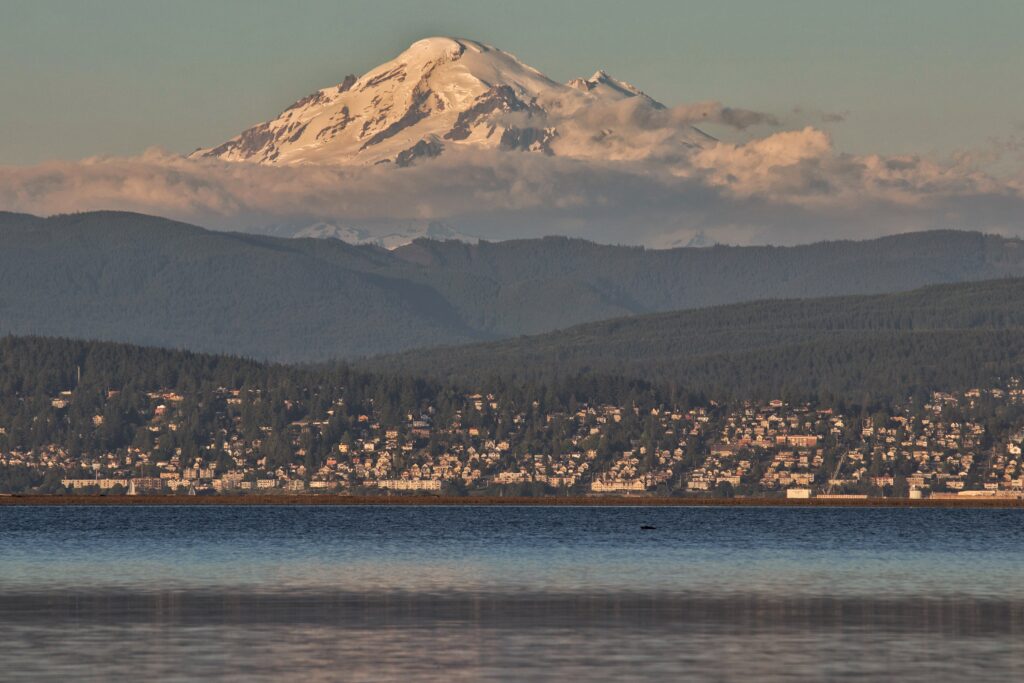
Tucked between the shores of Bellingham Bay and the snow-streaked ramparts of Mount Baker, Bellingham feels both rugged and refined — a university town that hums with youthful idealism and outdoor energy.
Here, salt air mingles with the scent of cedar. The Fairhaven Historic District charms with brick storefronts, bookshops, and cafés that open onto views of the islands. Kayakers trace the coastline; cyclists follow trails that weave from downtown to forest glades. And always, the mountains loom to the east, promising adventure.

Bellingham is a place of small delights: the farmers’ market spilling over with local produce, the sound of live music from a brewery patio, the quiet dignity of working harbors where fishermen mend their nets as the sun dips behind the San Juans.
It’s a city that lives deliberately, in balance with its surroundings — a model of what Pacific Northwest life can be: connected to nature, grounded in community, and endlessly curious about the world beyond the bay.
Spokane: The River City of the Inland Empire

If western Washington is defined by water in motion — the sea, the rain — then Spokane, in the state’s far eastern reaches, represents water harnessed: a river tamed but not silenced. The Spokane River roars through the heart of the city, plunging over basalt ledges in a spectacle of white spray and thunder.
Spokane is both pioneer and progressive, an inland outpost that has reinvented itself again and again. Its history lies in logging and mining, yet today it thrives on culture, higher education, and a growing spirit of renewal. The Riverfront Park, created for the 1974 World’s Fair, remains the city’s soul — a gathering place of bridges, sculpture, and green space that softens the industrial edges.

Downtown, brick warehouses now host cafés, boutiques, and art studios. Each spring, the city celebrates Bloomsday, one of the nation’s largest road races, a symbol of civic pride and endurance. And beyond the city limits, wheat fields roll toward Idaho, their golden arcs gleaming in the evening sun.
Spokane feels grounded — a city of the interior, where the pace slows and the sky opens. It’s Washington seen from the other side: less maritime, more continental, yet bound by the same resilient spirit.
Leavenworth: The Alpine Dream of the Cascades

Tucked within the eastern slopes of the Cascade Mountains, Leavenworth feels like a village pulled from the heart of Europe and placed amid evergreen peaks. Timbered chalets line the streets; flower boxes spill with geraniums; the air carries the scent of pine and pretzel dough.
But beneath its Bavarian façade lies a story of transformation. Once a declining logging town, Leavenworth reinvented itself in the 1960s as a mountain escape inspired by Alpine architecture — a gamble that became legend. Today, it thrives as both a cultural curiosity and a genuine mountain haven.

The Wenatchee River rushes just beyond town, its clear waters drawing rafters and kayakers in summer. In winter, snow softens the rooftops and lights twinkle beneath icicles as sleigh bells echo through the valley.
Beyond the festive veneer, Leavenworth’s greatest gift is its setting: endless trails leading into the Enchantments, a granite paradise of turquoise lakes and wildflower meadows. Here, the illusion fades and the real magic begins — a reminder that Washington’s Alps need no imitation.
Walla Walla: Vineyards, Valleys, and Vintage Dreams

In the southeastern corner of Washington, where rolling hills meet wide sky, Walla Walla has quietly become one of America’s most distinguished wine regions. Sunlight glows on the wheat fields; the Blue Mountains shimmer to the east; and in between lie vineyards that have transformed this once-sleepy town into a destination of taste and elegance.
Over 120 wineries now flourish here, producing world-class Cabernet Sauvignon, Syrah, and Merlot from the loamy soils of the Columbia Basin. Yet the town itself retains its small-town soul. Brick storefronts, art galleries, and family-owned restaurants line tree-shaded streets where time slows and conversation lingers.

Walla Walla’s rhythm is measured not in hours, but in vintages — each season bringing its own poetry of soil, sun, and human craft. Visit during harvest and you’ll feel it: the scent of grapes in the air, the hum of tractors, the communal pride in something beautiful and lasting.
It’s a place that pairs sophistication with sincerity — where the art of wine remains, at heart, an act of love for the land.
Mount St. Helens: The Living Volcano

At first glance, Mount St. Helens is a wound in the Earth — a vast crater torn open by the catastrophic eruption of May 18, 1980. But look closer, and it is also a miracle of renewal.

What was once a landscape of destruction is now an evolving testament to nature’s resilience. Forests have returned; elk graze in meadows born of ash; wildflowers bloom against the gray slopes. From the Johnston Ridge Observatory, the view into the mountain’s hollow heart is both haunting and sublime — a panorama of ruin becoming rebirth.

The eruption forever changed how the world understands volcanoes, yet it also changed how Washington understands itself. St. Helens stands as a reminder of the volatile power beneath this seemingly stable land — and of the life that persists in its wake.
To walk its trails is to feel humility sharpen into hope. The mountain destroyed — and then, astonishingly, began again.
Vancouver: The Gateway by the River
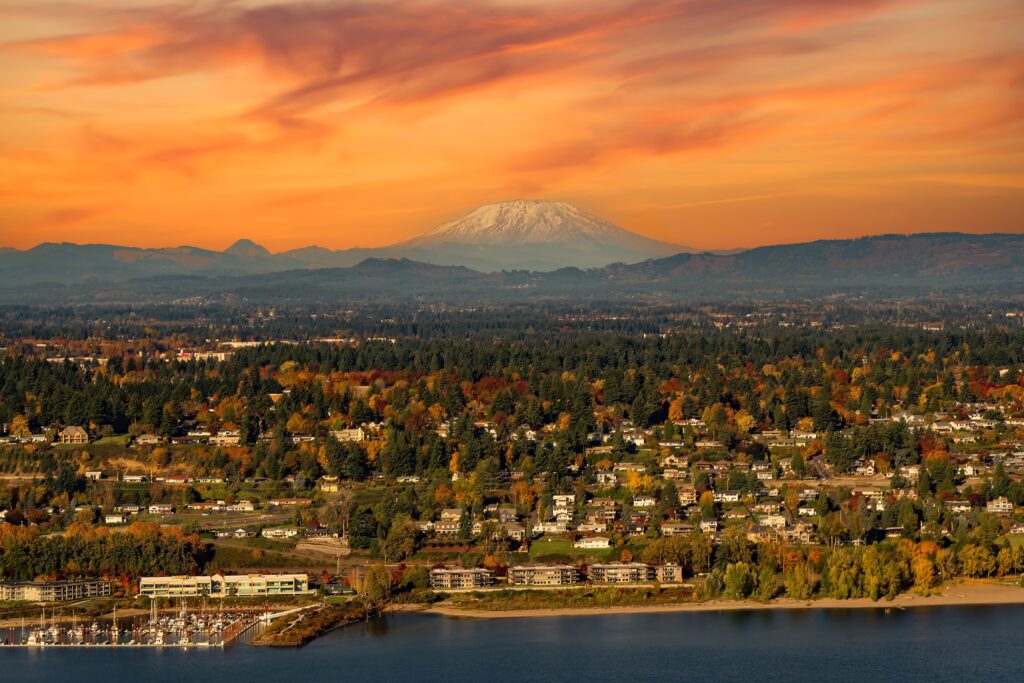
Across the Columbia from Portland lies Vancouver, a city that hums with quiet confidence — overshadowed by its famous neighbor, yet grounded in its own deep roots. Here, Washington began: at Fort Vancouver, where trappers, traders, and Indigenous peoples once converged under the British Hudson’s Bay Company flag.

Today, the old fort still stands — log walls encircling stories of the 19th century — while just beyond it, the Waterfront Renaissance Trail meanders beside the wide, silver river. Glass-fronted restaurants and sleek bridges now catch the sunset where canoes once landed.
Yet even amid modern renewal, the essence of Vancouver remains: a meeting place. Between Oregon and Washington. Between the old and the new. Between the rush of I-5 and the hush of the Columbia at dusk.
It’s a city of subtleties — less a place that demands attention, more one that rewards it. Watch the river glow pink at sundown, and you’ll understand why people here rarely hurry. The beauty is already flowing by.
The Columbia River Gorge: A Cathedral of Stone and Wind

Few landscapes in America are as breathtaking as the Columbia River Gorge, where the river carves a path between Washington and Oregon through sheer basalt cliffs crowned with waterfalls and forest. It is both a natural wonder and a sacred corridor — a place where the elements perform their oldest symphony.
From Beacon Rock to Cape Horn, Washington’s northern side offers wild solitude and panoramic views of the river far below. Trails wind through old-growth firs, each step echoing with wind and water. The gorge feels eternal, yet alive — changing with every season, every shaft of light.

Windsurfers trace bright arcs over the river’s surface near Hood River; hikers ascend to viewpoints like Dog Mountain, where spring brings seas of golden balsamroot. Eagles circle above the cliffs. Clouds drift through the valley like passing thoughts.
The Gorge humbles you — not with grandeur alone, but with balance. Water and rock, motion and stillness, presence and time. Standing there, you don’t just see the landscape; you feel part of its breath.
Yakima Valley: Sun, Soil, and the Scent of Harvest
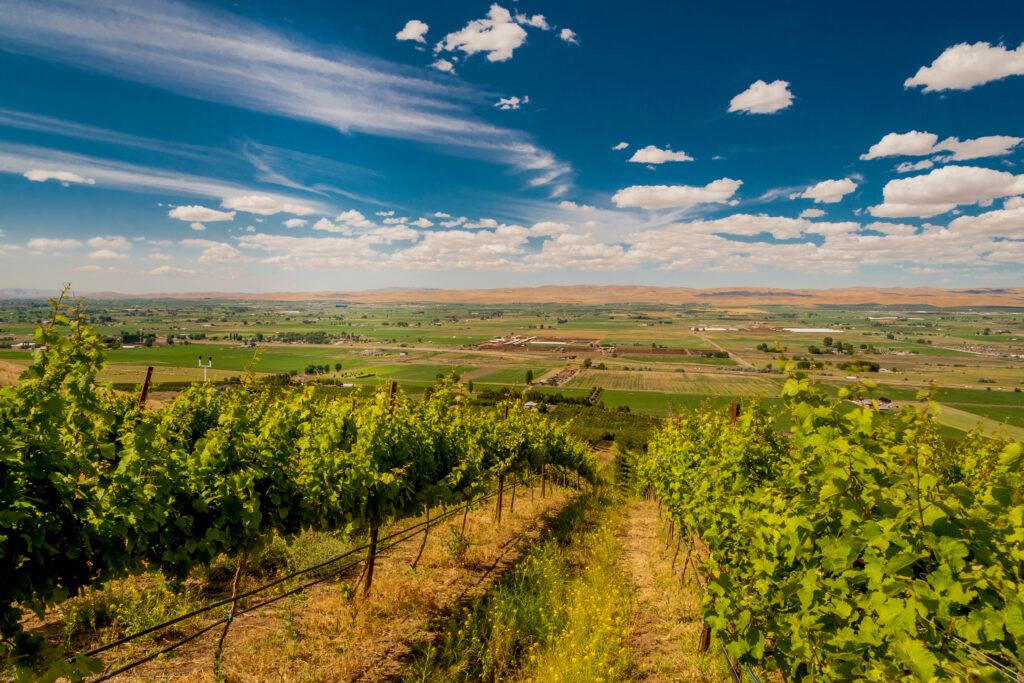
In a state famed for rain, Yakima Valley is a revelation of sunlight. Here the air is dry, the hills golden, and the horizon wide. Orchards stretch in every direction, bursting with cherries, apples, and hops — the quiet heart of Washington’s agricultural bounty.
It’s the hops, though, that make Yakima world-renowned: nearly three-quarters of all hops used in American craft beer come from this fertile basin. Breweries across the nation owe their bright, aromatic ales to the valley’s soil and sun. In September, the scent of hops fills the air, heady and sweet.

Beyond its fields, Yakima carries a rhythm of rural grace. Wineries dot the hillsides; roadside stands sell just-picked fruit; and the Yakima Greenway Trail follows the river through cottonwoods alive with birdsong.
There’s a grounded joy here — the feeling of living close to what sustains you. Under the vast, cloudless sky, the simple things shine brighter: a glass of local wine, a conversation in the shade, a slow drive home through rows of green and gold.
Mount Baker: The White Sentinel of the North

High above the forests of northern Washington rises Mount Baker, its gleaming snowfields visible for more than a hundred miles in every direction. Known to the Indigenous Lummi people as Koma Kulshan — “The White Watcher” — it stands as both guardian and symbol, a mountain of fierce beauty and quiet endurance.
In summer, alpine meadows near Artist Point explode in wildflowers — paintbrush and lupine blooming beneath turquoise skies. Glacial streams tumble down slopes where marmots whistle and eagles soar. In winter, deep snow cloaks the world in silence, broken only by the laughter of skiers at the Mount Baker Ski Area — famous for some of the heaviest snowfall on Earth.
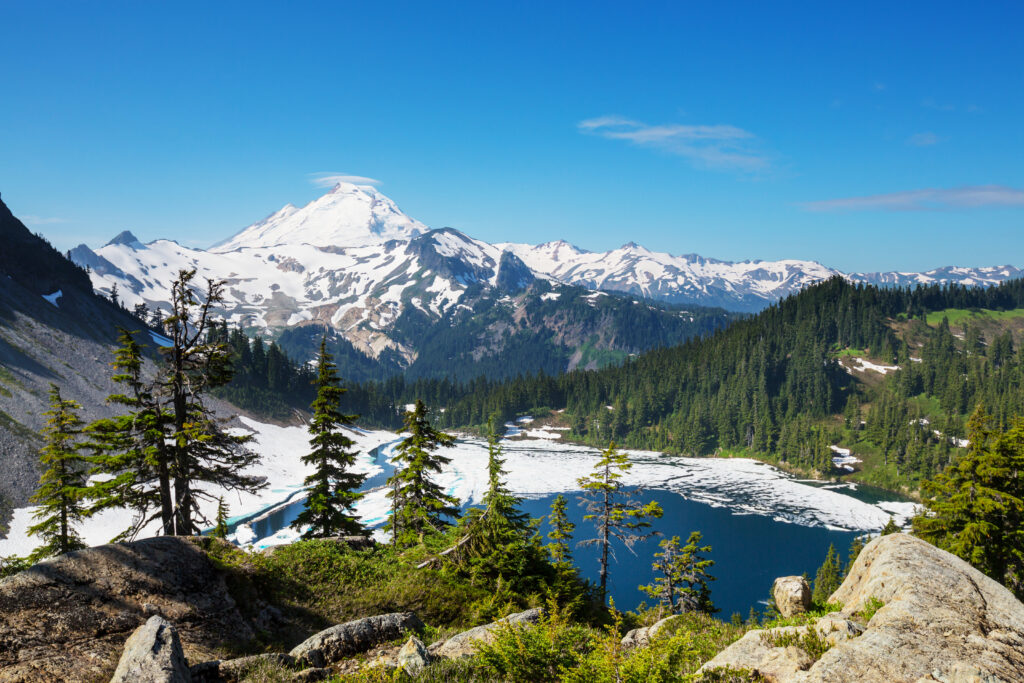
But Baker’s true majesty lies in its solitude. Even when the parking lots fill, the trails soon empty into silence. The mountain is not a spectacle to be consumed, but a presence to be approached with reverence. Its vastness humbles; its light restores. Standing there, amid the scent of pine and cold air, one feels at the roof of the Pacific Northwest — close to the clouds, closer still to wonder.
Deception Pass: The Bridge Between Worlds

There are few places on Earth where land and sea meet with such drama as at Deception Pass. Jagged cliffs plunge into emerald waters where tidal currents race like rivers; seabirds wheel above; and from the towering bridge, the world seems both infinite and contained.
Named by explorer George Vancouver, who was “deceived” by the maze of islands and inlets, Deception Pass is less about error than revelation. It’s where Washington’s rugged heart beats in full view — salt spray in your hair, firs clinging to stone, the cry of gulls carried on the wind.
Below the bridge, beaches stretch along both Whidbey and Fidalgo Islands, and trails thread through dense woods that open suddenly to breathtaking views of the Olympic Mountains. Whether at sunrise, when fog drifts like silk through the strait, or at sunset, when the water turns to gold, the pass feels timeless — a meeting of wild forces that has shaped both land and spirit.
Whidbey Island: A Dream Floating on the Sound

Sailing across Puget Sound to Whidbey Island feels like stepping into another rhythm of life — slower, more contemplative, and bound to nature’s cycles. The island stretches for nearly 40 miles, a mosaic of windswept beaches, rolling farmland, and sleepy villages.
In Langley, cafés overlook the water where gray whales surface each spring; in Coupeville, wooden wharves creak above eelgrass beds; and at Ebey’s Landing, fields meet cliffs that drop dramatically to the sea. It’s no wonder artists, writers, and dreamers have long been drawn here — the light itself seems to invite reflection.

Whidbey is a world apart yet never far from the mainland — a place of ferry horns, salt air, and conversations over homemade pie. Here, life moves with the tides. It is not a destination to tick off, but a rhythm to join, a quiet that lingers even after you’ve gone.
Lake Chelan: The Mirror of the Mountains

In the very center of Washington, cradled between steep, sunburnt slopes, lies Lake Chelan — a long, glacial ribbon of water so clear and deep it reflects both mountain and sky in perfect symmetry. Stretching more than fifty miles from the resort town of Chelan to the remote wilderness of Stehekin, it’s one of the purest and most peaceful lakes in the nation.
Chelan itself hums with summer energy — families on the beach, boats cutting across blue water, wineries dotting the hillsides. But the deeper magic lies upriver, beyond where the road ends. The only way to reach Stehekin is by ferry, floatplane, or foot — a remote hamlet where there are no stoplights, just the sound of the lake lapping against the dock and the smell of fresh bread from the famous Stehekin Bakery.
Lake Chelan is not just a place of beauty; it’s an invitation to stillness. Dawn comes gently over the ridges; evenings shimmer with golden light. And in the hush between them, you feel that rarest of sensations — true quiet, deep and cleansing, like water itself.
Ellensburg: The Heart of the Kittitas Valley

Set at the crossroads of east and west, Ellensburg feels like the soul of inland Washington — a town shaped by cattle drives, university life, and endless horizons. It’s where the rolling farmland of the Kittitas Valley meets the arid hills that rise toward the Cascades, a landscape caught between wild and cultivated.
Founded in the 19th century, Ellensburg still carries the charm of its frontier roots: red-brick buildings line Main Street, old feed stores now house art galleries and cafés, and the rhythm of ranch life lingers just beyond town. The Ellensburg Rodeo, one of the oldest in the country, remains a highlight — a weeklong celebration of grit, skill, and community spirit that fills the valley with dust, laughter, and pride.
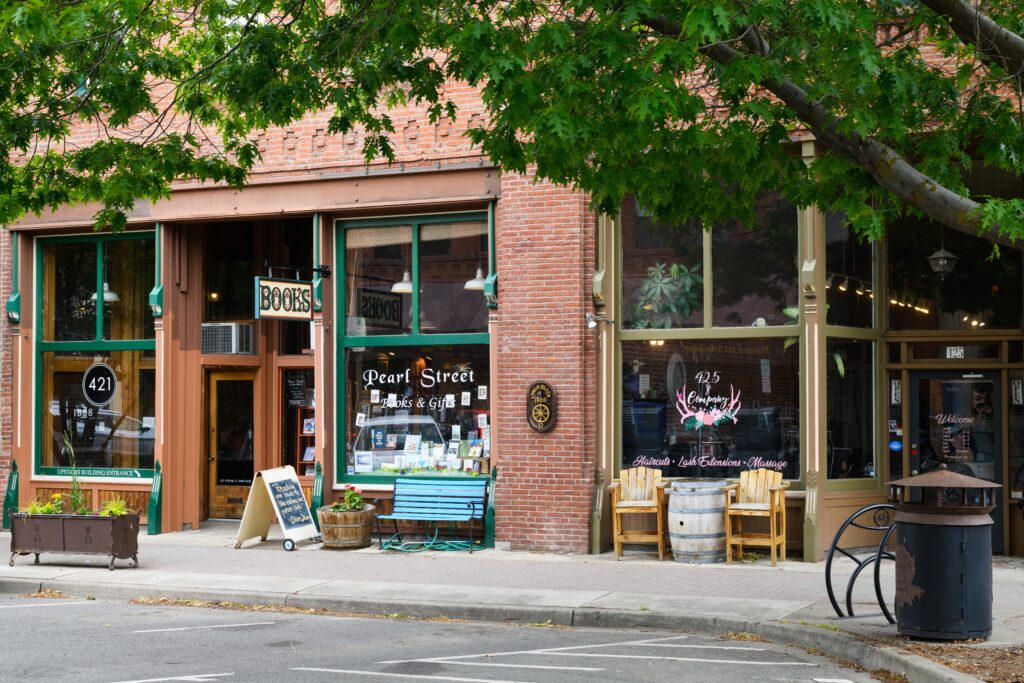
But Ellensburg is also a place of learning and renewal. The presence of Central Washington University adds youth and curiosity; the Yakima River Canyon nearby offers fly-fishing, rafting, and quiet reflection. Life here moves at the pace of the land — slow, steady, honest.
Ellensburg isn’t flashy. It doesn’t try to be. It’s simply real — the kind of town that anchors you, where sunsets turn wheat fields to gold and time feels well spent.
The Palouse: Washington’s Living Canvas

At the southeastern edge of the state, far from Seattle’s skyline or Puget Sound’s tides, the Palouse unfolds — a vast, undulating sea of hills that shimmer in shifting shades of green, gold, and brown. It is one of the most surreal and breathtaking landscapes in America, created not by design but by wind, soil, and time.

Seen from Steptoe Butte, the Palouse resembles a living painting — hills rising and falling like waves under the sky, patterned with wheat and barley fields that catch the light like silk. Farmers have worked this land for generations, yet it feels untouched, almost abstract in its beauty.
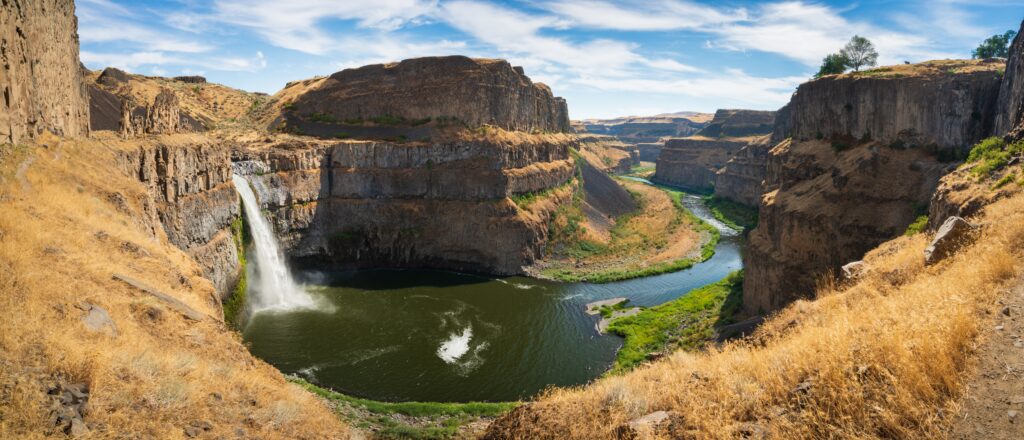
Small towns like Pullman and Colfax nestle among the hills, their quiet streets punctuated by grain silos and cafés that smell of coffee and dust. At harvest, combines crawl across the fields like slow-moving ships. And when the wind comes, it ripples through the wheat with a sound like breathing.
The Palouse reminds you that wonder isn’t always loud or dramatic — sometimes it’s the hush of open land, the play of light across earth, the sense that beauty can be both immense and humble.
Here, at the far end of Washington, the journey finds its close — not with applause, but with awe.

